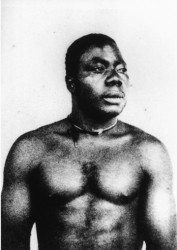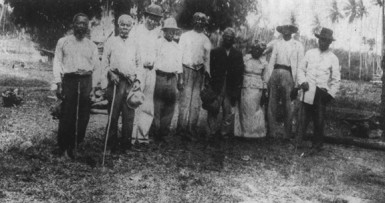By Cecilia McAlmont
This is an edited version of a ‘History This Week’ article which first appeared in Stabroek News on July 29, 2010
The Emancipation Act which was passed by the British Parliament in 1833 came after more than four decades of agitation and setbacks by the British Anti-Slavery movement. It was launched by Thomas Clarkson, Granville Sharpe and other Quakers in 1788. It also came as a result of the activities of what Beckles, Hart, Williams and other Caribbean historians describe as the Caribbean Anti-Slavery movement which manifested itself through the covert and overt actions of generations of the enslaved, specifically, the Berbice Slave Rebellion of 1763, San Domingue Revolution of 1791 and the slave rebellions in three British colonies in the decade-and-a-half preceding the passing of the Emancipation Act. The first significant blow was struck with the passing of the Abolition Act in 1807 not only after a long, hard campaign by the British abolitionists but because “Parliament was persuaded that the [British] national economy would be best served by the abolition.”

The abolitionists had hoped that self interest would force the planters to treat their slaves better, since it would no longer be possible to replace them as easily. Consequently, in some instances the emphasis shifted from “the slaver to the slave womb” that is, enslaved women, who in many colonies by the time of abolition were the majority of the all important field slaves, were now both producers and reproducers. This led to the introduction of several pronatalist policies by some planters. However, the brutalities and masochistic floggings of the enslaved, in general, but of women in particular continued unabated. Pressure from the humanitarians and a slave revolt in hitherto rebellion free Barbados in 1816 led to the introduction in 1823 of amelioration proposals which included, among other things, manumission by self purchase, acquisition of property and a minimization of the whipping of slaves, especially women. These proposals were observed more in the breach by the powerful planter dominated Assemblies even in the Guiana colonies and Trinidad where the governor had more decision making authority. The extent to which the proposals failed to achieve its goals was demonstrated by the imposition of a Slave Code in 1826 which included all the ameliorative measures it was hoped the planters would have implemented voluntarily. The situation of the enslaved did not improve because of the widespread evasion of the ameliorative measures by the Assemblies. Both abolitionists and government officials realized that outright emancipation of the slaves was the only answer. In 1831, a society for the abolition of slavery was formed and in fact its terms of reference were being debated in the British Parliament when the slave revolt began in Jamaica in December 1831. This act of defiance by the enslaved which was preceded by that of the enslaved in Demarara in 1823 without a doubt played a role in the passing of the Emancipation Act of 1833, because, according to Eric Williams, emancipation either had to be granted from above by the enslavers or be wrested from below by the enslaved. Emancipation came from above, but freedom was delayed.
The early Village Movement
Freedom was delayed through the imposition of a period of Apprenticeship of between four and six years during which the apprentices were forced to work for their former masters to ensure them a continuous supply of labour while they made other arrangements. It was therefore not lost on the apprentices that while the apprenticeship system imposed continued forced labour on them for the plantations, they were granted no incentives to sweeten the imposition. On the other hand, however, the slave owners were handsomely compensated for their lost property rights to the tune of a grant of twenty million pounds. Herein lay one of the several push factors that inspired the village movement not only in Guiana but in the other larger territories of Trinidad and Jamaica where the phenomenon mainly manifested itself.
There were clear indications, at least in British Guiana, long before the end of apprenticeship that many of the newly freed would leave the estates as a means of asserting their independence. This was possible because of the availability of large tracts of unoccupied lands. The planters reasoned that if the newly freed could be kept landless then they would be forced to continue to work on the plantations to provide themselves and their families with the necessities that had been guaranteed by law during slavery and apprenticeship. With the connivance of the Colonial Office, laws were passed to prevent the legitimate and illegitimate use of Crown lands. Under an apprenticeship Order-in-Council, apprentices could be arrested if they were found more than five miles away from their plantations and they could be sent to prison for three months with hard labour if they occupied waste land without permission. More importantly, however, legitimate acquisition of Crown land was made almost prohibitive because a minimum of one hundred acres had to be purchased at one pound per acre.

While most of the planters followed these and other confrontational policies like cutting down the fruit trees on the plantations that the apprentices had planted to prevent them from picking the fruits, others reasoned that if the ex-apprentices owned and lived on land on or near to the estates, they were more than likely to work on the nearby plantation when the need arose. By the end of 1839, according to Alan Young, labourers had constructed some 267 cottages on plots of land of varying sizes. This was the beginning of the Proprietary Villages the most famous of which was Queenstown which was made up of three adjoining estates on the Esse-quibo coast – Daagerad, Mocha and Westfield. They were purchased by a progressive planter who divided them into half acre lots and sold them for prices ranging from $100 to $220 depending on their location in the town. This practice soon spread to Demerara and Berbice.
However, the attitude of some planters caused the fear of the loss of labour to become a self-fulfilling prophecy. While for the most part the male ex-apprentices were prepared to continue to work on the estates, they wanted their wives to stay at home and take care of their families and their children to attend the schools which were being set up. Additionally, those who had acquired skills wanted to negotiate better wages. This led to confrontation with the planters who refused to accept their former slaves as citizens and free labourers with the rights and privileges which went with that status.
As a consequence, many of the ex-slaves sought to underscore their status as freemen and their independence from the plantations on which they had encountered so much humiliation and suffered so many indignities. They demonstrated this by purchasing some of the over 50, mainly cotton estates, that had been abandoned. The first such purchase was made on November 2, 1839 when 83 labourers from five estates, Dochfour, Ann’s Grove, Hope, Paradise and Enmore together purchased Plantation Northbrook for $10,000. After an initial down payment of $6,000, the remainder was paid off within three weeks. This was the beginning of the Communal Villages that were to be set up. They were so called, because unlike the Proprietary Villages where each villager held title to his/her individual plot of land, there was one common title for all of the villagers. In the case of the first village which through a petition by the villagers to the Queen was named Victoria, the title was vested in the names of six of the most prominent of the purchasers with the understanding that each of the subscribers was entitled to one undivided eighty-third share of the entire plantation. But this system which initially was the basic strength of the village movement ultimately turned out to be the greatest threat to its economic viability.
Buxton

By 1840, four Communal Villages were established in West Coast Berbice through the purchase of Golden Grove, 500 acres for $1,716; St John, 252 acres for $5,000; east half of Perseverance, 250 acres for $2,000; and Lichfield, 500 acres for $3,000. However the effect of all the purchases that had been made, led to what would now be hyper-inflation and was reflected in the prices now asked for abandoned estates. It was under these conditions that the same year, 128 ex-apprentices from seven nearby plantations were asked to pay $50, 000 for New Orange Nassau, an abandoned cotton plantation of 500 acres. The price of the 500 acres represented nearly 450% of the price ($11,716) paid by 170 labourers for the above mentioned combined 1,505 acres, a little more than three times the amount of land. It meant that each of the original purchasers of Buxton paid nearly $3,500 for their less than four acres of land.
It is indeed a significant achievement.




